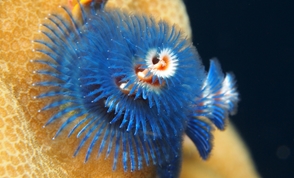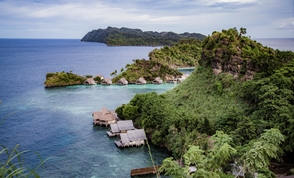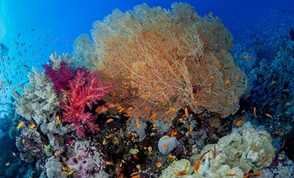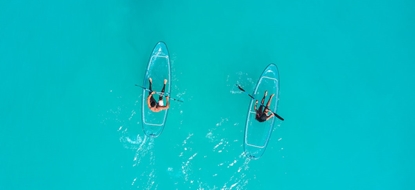A Beginner's Guide to Underwater Photography
Taking a camera down with you adds a whole new dimension to diving and can be deeply rewarding. If you want to capture great snaps though, you’ll need to do your homework. Underwater photography is very different to taking pictures above the surface and can be tricky to master – even experienced photographers often struggle at the beginning. We’ve pulled together our top tips to help you get started.

Learn how light behaves underwater
Understanding how light works as it travels through water is key to your success in taking good shots. The reason everything looks blue below the surface is because water molecules absorb light. Higher wavelength colours such as red are lost first, then orange, yellow, green and eventually blue. This means that underwater photos often appear blue, dark and low in contrast. The deeper you dive, the darker and bluer everything becomes. This applies horizontally as well as vertically, too – colour gets washed out the further away you are from an object. There are two ways around this: using a strobe (flash) and adjusting the white balance. The former allows white light produced from a flash to reintroduce those missing reds and other colours, but a common problem is backscatter. This looks like dust or dirt on your lens but is actually due to particles in the water catching the light. It’s problematic especially with compact cameras, which have an internal flash. Unless you are shooting at shallow depths and are very close to your subject, it’s worth investing in an external strobe, attached by an adjustable arm. This allows you to control the lighting more finely – by angling the arm and adjusting the strength of the flash to get a perfect exposure. The downside? They are expensive. The other option is to adjust your camera’s white balance, either manually on the camera or when editing photos on your computer. For most point-and-shoot cameras, manual adjustment is your best bet. Check your instruction booklet as each camera is different, but it generally involves taking a photo of something you know is white (even if it looks blue underwater) and making the camera save these settings, ‘tricking’ it into compensating for the light difference at depth.

Mastering buoyancy control
It’s really important to avoid contact with coral when diving, or indeed snorkelling. As well as being potentially very painful to you and risking a skin infection, it can cause immense damage to the coral. While many people think they are plants, corals are in fact animals and are evolutionary relatives of jellyfish. Their vivid colours come from a symbiotic micro-organism called zooxanthellae, which lives inside the coral polyps and uses photosynthesis to supply the coral with the majority of its food. Coral polyps protect themselves (and their symbiotic zooxanthellae) from infection with a mucus layer. When this is touched or knocked by fins, two things may happen – the mucus layer may be damaged and the coral is then exposed to pathogens, and a stress response is triggered which causes the coral to eject their zooxanthellae. This event is called ‘bleaching’ because without the pigmented zooxanthellae, the coral loses its bright colour and becomes white. If the damage is severe, the polyps will die. A study by the Reef-World Foundation found that almost half of diver contacts with the reef were caused by fins. So it’s well worth spending some time improving your finning techniques to avoid unnecessary bumps – in particular, the frog kick and back kick. Ask an instructor to help you if you’re struggling to master these.

Book photography classes to learn the basics
It’s well worth investing some time in classes or workshops to help you master the basics and give you the confidence to get going. Both BSAC (British Sub-Aqua Club) and PADI (Professional Association of Diving Instructors) run courses which combine theory and practical sessions. You’ll learn the basics of using a digital camera underwater, how to handle optical issues, the features of cameras and underwater housings, tips on shooting technique and how to use photo-editing software. Visit www.bsac.com or www.padi.com for more information.

Pick the right destination for your subject matter
If you have your heart set on capturing a specific type of marine life, tailor your trip to ensure you have the best chance of snapping it. For example, if you’re keen to take wide-angle shots of schooling sharks and other big fish, we would suggest areas such as the Galapagos archipelago, Cocos Island or Socorro Island. More into macro? We can organise special macro photography workshops in the Philippines (for newbies, ‘macro’ diving refers to the kind of lens used to capture very small sea critters). Anilao in particular is the place for blackwater diving, a thrilling opportunity for experienced divers looking to take their macro to the next level. After dark, a weighted line is lowered from a float into deep water, with lights attached at intervals to attract all sorts of weird and wonderful species. Or perhaps you’re looking to capture colourful reefscapes, in which case we’d suggest North Sulawesi (Indonesia) or the Solomon Islands. This is where it really pays to use a specialist dive company for your next diving holiday – our insider knowledge and passion means we can direct you exactly where you need to be.

Learning from the best
There’s nothing like feasting your eyes on the work of top underwater photographers to get you excited and inspired for your next diving holiday. These are some of our favourites to follow on Instagram – and there’s always our very own Reefscape account for dreamy diving shots, too! Thomas P. Peschak is a wildlife photojournalist and conservationist who regularly shoots for National Geographic, with extraordinary underwater images. Brian Skerry also specialises in marine wildlife, with an impressive portfolio – he has been awarded Wildlife Photographer of the Year 11 times. For incredible shark photos, try Juan Oliphant, a passionate conservationist and talented marine photographer. UK-based Alex Mustard is a multi award-winning photographer who leads photography trips all over the world and has a stunning portfolio from his travels. Finally, Jennifer Hayes and partner David Doubliet are a dream photographic duo, collaborating on National Geographic assignments from the polar icecaps to the remote tropical coral reefs.












